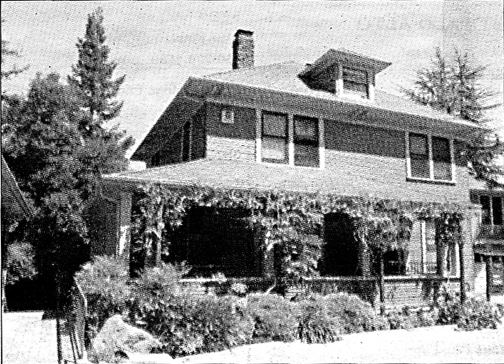 Palo Alto Stanford Heritage
Palo Alto Stanford Heritage 
Accounts vary as to whether Bertha Berner (1861–1945) was born in Oconomowoc, Wisconsin to German immigrant parents or whether she arrived there with them as a three year old. Her father, August, was a hardware merchant, and her mother, Mary, was a homemaker who raised two daughters and three sons. Shortly after finishing her education, Bertha left for California, where in the early 1880’s she became Jane Lathrop Stanford’s personal secretary and companion, a position she held until the latter’s death in 1905. When not traveling the country and the world with the Stanfords, Bertha lived with them in their residences in Sacramento, San Francisco and on the Stanford campus. The relationship between Bertha and her employer was a cordial one. According to a Palo Alto paper, a “great house in the Palo Alto foothills [was] given to Miss Berner by Mrs. Stanford….” The house was located on the north side of campus at present day Sand Hill Road and Junipero Serra. Called Monte Verde, it was a generous gift, and, although the architect is not mentioned, it is likely that architect, Charles Hodges designed Bertha’s house.
Charles Edward Hodges (1866–1943) worked for the London architectural firm of N. S. Joseph & Pearson from 1884 to 1888 while a student at Westminster and South Kensington Architectural Schools. At the age of 24, he immigrated to Boston where he was employed from 1888 to 1899 as a draftsman by the Boston firm of Shepley, Rutan and Coolidge. Coolidge’s firm, founded by the noted architect H. H. Richardson, was hired by Jane and Leland Stanford in 1888 to design the university which would commemorate their son, Leland, Jr., who had died in 1884. Coolidge sent Hodges west in 1893 to serve as draftsman and supervising architect for the Stanford project. Recently married to Myrtis Delano Charles and soon to be the father of three children, he settled on campus in Pine Cottage. Hodges’ main body of work consists of two distinct periods: The Stanford Years: 1893–1906, when he designed the earliest faculty housing and professor’s residences in Palo Alto and also supervised the construction of Stanford’s institutional buildings, and the San Francisco Bay Area Years: 1910–1917. His domestic architecture allowed him free rein to demonstrate his architectural skill without interference from his employers. By 1899, the Stanfords severed ties with the Coolidge firm and Jane Stanford appointed Charles Hodges resident architect in 1900, a post he held until 1906.
Monte Verde is a two story 2,800 square foot Colonial Revival with clapboard siding, two clinker brick chimneys and a hipped roof. The enclosed eaves have double decorative brackets, which are repeated three times along each eave and rest on a deep fascia board. Decorative boarding is repeated at the vertical edges of the building and at the ground. Dormer windows with hipped roofs pierce the attic roof. They are double hung, as are the tall, rectangular windows on both the 1st and 2nd floors. Simple wood molding surrounds them. A decorative, semi–hexagonal bay window on the left side has a hipped roof with several layers of molding beneath.
The wraparound porch, covering ¾ of the façade, is supported by square Doric columns resting on a clapboard balustrade. An asymmetrically placed entry door within the porch opens to an elegant foyer with oak parquet floors. The latter are repeated in spectacular fashion in the parlors and dining room. Bedrooms and a rear sun porch are reached by a U–shaped staircase leading to the bedrooms and a sun porch at the rear. Bertha’s house had ample space for her mother and siblings who often lived there when Bertha and Mrs. Stanford were in the campus area.
The lives of Bertha Berner and Charles Hodges changed radically between 1905 and 1906. Although Bertha was exonerated in Jane Stanford’s 1905 death from strychnine poisoning in a Hawaiian hotel, there were times when she was considered the likely perpetrator. Despite these suspicions, Bertha continued to live in her Menlo Park house, leading a comfortable life made possible by Jane’s $15,000 bequest to her. Her social life revolved around the University, which, in 1935, published her 213 page book entitled, Charles Hodges was less fortunate when the 1906 earthquake destroyed major university buildings. Although he, too, was exonerated by a Trustee–appointed committee, the quake damage cast a shadow on his reputation, leading to his resignation and departure from the area for four years. It is hard to imagine that the lives of the businesses currently occupying 2100 Sand Hill Road could match those of Jane, Bertha and Charles. The fortunate survival of this simple Colonial Revival building allows us the luxury of remembering. ©
PAST August 7, 2015
E-mail us at either webmaster@pastheritage.org or president@pastheritage.org.
![]() Palo Alto Stanford Heritage—Dedicated to the preservation of Palo Alto's historic buildings.
Palo Alto Stanford Heritage—Dedicated to the preservation of Palo Alto's historic buildings.
Copyright © 2012 Palo Alto Stanford Heritage. All rights reserved.